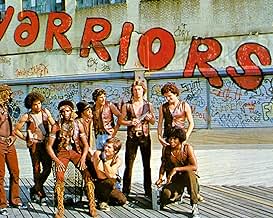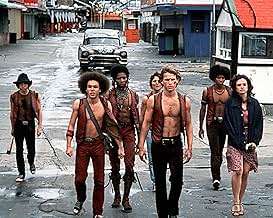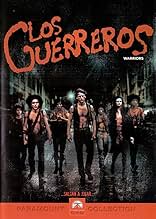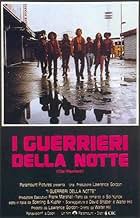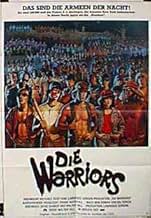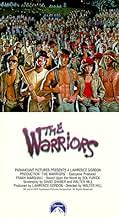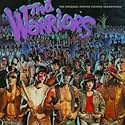Dans un avenir proche, un leader charismatique convoque les gangs de rue de New York. Quand il est tué, les guerriers sont accusés à tort et doivent maintenant se battre pour rentrer chez eu... Tout lireDans un avenir proche, un leader charismatique convoque les gangs de rue de New York. Quand il est tué, les guerriers sont accusés à tort et doivent maintenant se battre pour rentrer chez eux alors que tous les autres gangs les pourchassent.Dans un avenir proche, un leader charismatique convoque les gangs de rue de New York. Quand il est tué, les guerriers sont accusés à tort et doivent maintenant se battre pour rentrer chez eux alors que tous les autres gangs les pourchassent.
- Réalisation
- Scénario
- Casting principal
Marcelino Sánchez
- Rembrandt
- (as Marcelino Sanchez)
Avis à la une
I was working in a movie theater when The Warriors first came out, and remember well the flick and the hype surrounding it. Here's a few notes to clear up some misconceptions that many other commentors seem to have.
The flick was NOT ever intended to be an accurate portrayal of New York gang life, although there were some realistic elements. At the time it was generally accepted that it took place in the future, although nothing in the movie supports this. At best it can be considered an urban fable that takes place in a sort-of-imaginary world. You know, like Pulp Fiction (you think 90s LA gangsters dressed like that??).
Second, the film itself was not accused of inciting violence. Problem was, it was a VERY popular film with gang members, who would show up in force. Two rival gangs would show up at the same theater, and... you can figure the rest out yourself. One guy was killed on the first weekend the movie was playing in New York; after that, the distributor hired off-duty police for security at every theater across the country that showed the flick. In the small-town Midwest where I lived, this served more as advertising hype than anything else.
Finally, it was widely known back in the day that The Warriors was based on the ancient Greek nonfiction tale Anabasis, written around 370 BC by the Spartan general Xenophon (it's also published under the title The Persian Expedition). In this classic tale, a battalion of 10,000 Spartan mercenaries join the Persian emperor Cyrus for a war in Asia Minor (i.e. Turkey). Cyrus's army is defeated, the Spartan leaders are captured, and the remaining force must make their way across country, fighting various hostile tribes along the way, experiencing their own internal power struggles, until they reach the safety of the sea. I'm shocked that only one reviewer seemed to be familiar with this; in the 70s almost nobody talked about the movie without mentioning it.
Great flick, by the way, and it holds up extremely well over time. I'm sure the remake will suck.
The flick was NOT ever intended to be an accurate portrayal of New York gang life, although there were some realistic elements. At the time it was generally accepted that it took place in the future, although nothing in the movie supports this. At best it can be considered an urban fable that takes place in a sort-of-imaginary world. You know, like Pulp Fiction (you think 90s LA gangsters dressed like that??).
Second, the film itself was not accused of inciting violence. Problem was, it was a VERY popular film with gang members, who would show up in force. Two rival gangs would show up at the same theater, and... you can figure the rest out yourself. One guy was killed on the first weekend the movie was playing in New York; after that, the distributor hired off-duty police for security at every theater across the country that showed the flick. In the small-town Midwest where I lived, this served more as advertising hype than anything else.
Finally, it was widely known back in the day that The Warriors was based on the ancient Greek nonfiction tale Anabasis, written around 370 BC by the Spartan general Xenophon (it's also published under the title The Persian Expedition). In this classic tale, a battalion of 10,000 Spartan mercenaries join the Persian emperor Cyrus for a war in Asia Minor (i.e. Turkey). Cyrus's army is defeated, the Spartan leaders are captured, and the remaining force must make their way across country, fighting various hostile tribes along the way, experiencing their own internal power struggles, until they reach the safety of the sea. I'm shocked that only one reviewer seemed to be familiar with this; in the 70s almost nobody talked about the movie without mentioning it.
Great flick, by the way, and it holds up extremely well over time. I'm sure the remake will suck.
Just a couple of points to add to the general accolades above:
Here in England the BBC have twice shown a version of The Warriors with a prologue scene, edited from the released movie but restored to a point prior to the opening 'Wonder Wheel' shot. It shows Cleon (an otherwise very underused character), sitting on the Boardwalk in the late afternoon sunshine waiting for his eight footsoldiers to show, while his girlfriend pleads with him not to go to the Bronx. When the others arrive and line up he designates their roles, including the "Swan: War chief and second in command" alluded to later in the movie. Ajax gives an early sign of his belligerent nature, voicing his disapproval with bringing a boombox-guy and a graffiti-artist: "They'll only slow us down", but seems happy to be labelled as "Heavy Muscle" along with Cochise. Much of the dialogue from this scene is re-used in the credit-sequence, with the shots of Coney and the gathering forces intercut with short interchange between Warriors. However, the prologue scene ends unforgettably with a crane-shot of the nine striding up the Boardwalk and into the distance, casting long shadows on the decking and with Cleon's girlfriend trailing in their wake. Over this, a slow sixties surf-tune booms out as the waves wash against the shore. Bloody wonderful.
Unfortunately I have never found a store-bought version which includes this material - DVD community, do you know?
Another thing I heard was that the original idea was that the movie was set "Sometime In The Near Future", but Walter Hill dropped the idea of having a caption stating as much at the start of the film. This explains some of the discrepancies with the actual New York gangland, being more about delinquent youth and 'Colours' than Organised Crime syndicates and shiny suits.
Third - a fantastic action movie full of colour, vim and attitude, but which also never fails to break my heart every time I watch it. There are a couple of scenes like this - mostly Deborah Van Valkenburgh's - but the main one is with Swan and Mercy on the Subway as the High School 'Preppies' complete with ruffled shirts and massive lapels sit down opposite, their laughter and smiles soon fading as the contrast becomes blindingly obvious to them as well as us. Walter Hill plays this scene perfectly: with no dialogue as such, and with Swan and Mercy not even looking at each other as he takes her hand from her hair and places it firmly by her side. Och, goosebumps even thinking about it!
Finally, having also read the original 'Anabasis' (I had to) when I was studying Ancient Civilisations of the Med at University, as a piece of pure drama The Warriors could shove a bat up it's ass and turn it into a Popsicle. Can You Dig It?!
Here in England the BBC have twice shown a version of The Warriors with a prologue scene, edited from the released movie but restored to a point prior to the opening 'Wonder Wheel' shot. It shows Cleon (an otherwise very underused character), sitting on the Boardwalk in the late afternoon sunshine waiting for his eight footsoldiers to show, while his girlfriend pleads with him not to go to the Bronx. When the others arrive and line up he designates their roles, including the "Swan: War chief and second in command" alluded to later in the movie. Ajax gives an early sign of his belligerent nature, voicing his disapproval with bringing a boombox-guy and a graffiti-artist: "They'll only slow us down", but seems happy to be labelled as "Heavy Muscle" along with Cochise. Much of the dialogue from this scene is re-used in the credit-sequence, with the shots of Coney and the gathering forces intercut with short interchange between Warriors. However, the prologue scene ends unforgettably with a crane-shot of the nine striding up the Boardwalk and into the distance, casting long shadows on the decking and with Cleon's girlfriend trailing in their wake. Over this, a slow sixties surf-tune booms out as the waves wash against the shore. Bloody wonderful.
Unfortunately I have never found a store-bought version which includes this material - DVD community, do you know?
Another thing I heard was that the original idea was that the movie was set "Sometime In The Near Future", but Walter Hill dropped the idea of having a caption stating as much at the start of the film. This explains some of the discrepancies with the actual New York gangland, being more about delinquent youth and 'Colours' than Organised Crime syndicates and shiny suits.
Third - a fantastic action movie full of colour, vim and attitude, but which also never fails to break my heart every time I watch it. There are a couple of scenes like this - mostly Deborah Van Valkenburgh's - but the main one is with Swan and Mercy on the Subway as the High School 'Preppies' complete with ruffled shirts and massive lapels sit down opposite, their laughter and smiles soon fading as the contrast becomes blindingly obvious to them as well as us. Walter Hill plays this scene perfectly: with no dialogue as such, and with Swan and Mercy not even looking at each other as he takes her hand from her hair and places it firmly by her side. Och, goosebumps even thinking about it!
Finally, having also read the original 'Anabasis' (I had to) when I was studying Ancient Civilisations of the Med at University, as a piece of pure drama The Warriors could shove a bat up it's ass and turn it into a Popsicle. Can You Dig It?!
There are numerous reasons why Walter Hill's THE WARRIORS remains a classic film - and arguably not simply a cult classic, but a true classic - despite its very much of-its-time sensibilities. Somewhat ironically, the movie's acting is not among those reasons. With the exception of two bravura efforts by Roger Hill and David Patrick Kelly, one will not find "command performances" here (although James Remar and Deborah Van Valkenburgh do gnaw quite a bit on the scenery). Other than that, the acting is hard-boiled and generic. But then, the lack of flair in the acting department is arguably one of the film's unsung strengths. As the main protagonist, for example, Michael Beck, while not exactly sympathetic, is an easily relatable hero. He's very much like Henry Fonda in 12 ANGRY MEN - except, of course, for the long hair and the bare chest.
Much more remarkable are all the ways in which THE WARRIORS managed to create a thrilling cinematic experience that still holds up today, despite its low budget. The list is a long one: set design (such as it is), dialogue, music, costume design, makeup, thematic elements. But most worthy of mention is Andrew Laszlo's cinematography. I love the camera's aesthetic, which is very "1970s" but, in a number of ways, is more compelling than any filmic style you'll see today. It is rooted in realism, but the "reality" it depicts is clearly a "heightened" variety, as we see the dark New York City streets illuminated as if by nighttime stage lights. And the outlandish goings-on seen throughout much of the film compound the surreal atmosphere. The end result is wonderfully paradoxical: it is an awe-inspiring experience to imagine that the fantastical events depicted could actually be happening, or once did happen.
But the "look" of this film would be insignificant without a strong story and solid thematic content, and THE WARRIORS possesses these in spades. It is remembered, somewhat condescendingly, as a "typical" late '70s film, but I think it is more accurate to think of it as a '60s film made a full decade too late. It is, after all, adapted from Sol Yurick's 1965 novel of the same name (and its tagline, "These are the armies of the night," obviously echoes the title of Norman Mailer's 1968 novel). More to the point, the movie's premise of a gangland insurrection contains quite a few overtones and undertones of political radicalism, and visual reminders of the '60s counterculture are not uncommon. (It is interesting to note that the original novel was inspired in part by Xenophon's 4th century B. C. epic ANABASIS, so the film also offers allusions to Greek myth and legend for those who care to look for them.)
But there is so much more in THE WARRIORS to capture the imagination. The movie's soundtrack - an assortment of disco, hard rock, and early synthpop, plus a few would-be radio hits - is rightly famous, as is its carnivalesque depiction of inner-city life (an influence on the Insane Clown Posse's "Dark Carnival" mythology, perhaps?). The action sequences, too, are first-rate - intense and thrilling. (Given that the cops who are looking for the Warriors are no less silently menacing than the rival gang members out for revenge, the mood of suspense is non-stop.) And few films have captured the frustration and tedium of making one's way through New York City's countless neighborhoods more effectively than this one.
It is unfortunate that THE WARRIORS will probably never be taken completely seriously by film critics and historians, in part because of the campy 2005 video game adaptation released in its "honor" (which I have played, and which is undeniably addictive and a hell of a lot of fun). But all those who are able to peer beyond the lens of the "cult" prejudice will be able to appreciate both Walter Hill's cinematic genius and his penchant for visual pizazz. From the opening image of a lit-up Ferris wheel - both innocent and eerie - to the final shot of a carefree romp along Coney Island's beach, THE WARRIORS is unforgettable.
Much more remarkable are all the ways in which THE WARRIORS managed to create a thrilling cinematic experience that still holds up today, despite its low budget. The list is a long one: set design (such as it is), dialogue, music, costume design, makeup, thematic elements. But most worthy of mention is Andrew Laszlo's cinematography. I love the camera's aesthetic, which is very "1970s" but, in a number of ways, is more compelling than any filmic style you'll see today. It is rooted in realism, but the "reality" it depicts is clearly a "heightened" variety, as we see the dark New York City streets illuminated as if by nighttime stage lights. And the outlandish goings-on seen throughout much of the film compound the surreal atmosphere. The end result is wonderfully paradoxical: it is an awe-inspiring experience to imagine that the fantastical events depicted could actually be happening, or once did happen.
But the "look" of this film would be insignificant without a strong story and solid thematic content, and THE WARRIORS possesses these in spades. It is remembered, somewhat condescendingly, as a "typical" late '70s film, but I think it is more accurate to think of it as a '60s film made a full decade too late. It is, after all, adapted from Sol Yurick's 1965 novel of the same name (and its tagline, "These are the armies of the night," obviously echoes the title of Norman Mailer's 1968 novel). More to the point, the movie's premise of a gangland insurrection contains quite a few overtones and undertones of political radicalism, and visual reminders of the '60s counterculture are not uncommon. (It is interesting to note that the original novel was inspired in part by Xenophon's 4th century B. C. epic ANABASIS, so the film also offers allusions to Greek myth and legend for those who care to look for them.)
But there is so much more in THE WARRIORS to capture the imagination. The movie's soundtrack - an assortment of disco, hard rock, and early synthpop, plus a few would-be radio hits - is rightly famous, as is its carnivalesque depiction of inner-city life (an influence on the Insane Clown Posse's "Dark Carnival" mythology, perhaps?). The action sequences, too, are first-rate - intense and thrilling. (Given that the cops who are looking for the Warriors are no less silently menacing than the rival gang members out for revenge, the mood of suspense is non-stop.) And few films have captured the frustration and tedium of making one's way through New York City's countless neighborhoods more effectively than this one.
It is unfortunate that THE WARRIORS will probably never be taken completely seriously by film critics and historians, in part because of the campy 2005 video game adaptation released in its "honor" (which I have played, and which is undeniably addictive and a hell of a lot of fun). But all those who are able to peer beyond the lens of the "cult" prejudice will be able to appreciate both Walter Hill's cinematic genius and his penchant for visual pizazz. From the opening image of a lit-up Ferris wheel - both innocent and eerie - to the final shot of a carefree romp along Coney Island's beach, THE WARRIORS is unforgettable.
Several scenes alone are worth the price of admission. What a burst of visual imagination assembling New York's gangs in a single place with an elevated Cyrus presiding at the center. It's a great piece of staging as the camera pans over the throngs of cheering youth decked out in their gang colors, enough to give the cops and everyone else the terminal shudders. Then again, how much worse would they be running the city than the gang of white-collar billionaires usually in charge. I sympathize with Swan when he surveys his dilapidated home turf saying it's a heck-uv-a place to have to return to. Seems to me he's got at least as much class as any New York politician. It's not the gangs that give rise to gangs, it's the people in charge who create the hopeless conditions.
Great color photography as Swan and the Warriors repeat an ancient Greek legend by battling their way home across miles of hostile territory. I like the realistic way macho insults are used to shame the reluctant into aggressive tacticsmuch the way the army does. Then again, boys will be boys, ready for a little side action, even when it's not the smart thing to do as several of the troops find out. The combat scenes may not be very realistic, but they are well choreographed. Another bit of clever staging-- the Rogues (I think) standing outside the Men's Room stalls and you know something's going to happen, but what? Then it's blitzkrieg with some slick choreography.
Smart bit of scripting to insert the two upper-class couples into the subway across from Swan and his cheap-looking girl (Mercy). It's a clash of classes, like the city itself. Notice Swan's hard-eyed stare and how he keeps Mercy from primping herself to look more presentable to their social betters. Swan knows the score. It's all about dignity, no matter where you come from or how you look. And despite all the fighting, I think that's what the movie's really aboutdignity among the city's social rejects, how to get it and how to keep it. That way you know that even if you never get beyond your home turf, you still qualify at a basic level. That's also why at movie's end, we know Swan will never reach a place like the mayor's office. But that's okay because they know and we know-- he and his men do qualify. Good flick.
Great color photography as Swan and the Warriors repeat an ancient Greek legend by battling their way home across miles of hostile territory. I like the realistic way macho insults are used to shame the reluctant into aggressive tacticsmuch the way the army does. Then again, boys will be boys, ready for a little side action, even when it's not the smart thing to do as several of the troops find out. The combat scenes may not be very realistic, but they are well choreographed. Another bit of clever staging-- the Rogues (I think) standing outside the Men's Room stalls and you know something's going to happen, but what? Then it's blitzkrieg with some slick choreography.
Smart bit of scripting to insert the two upper-class couples into the subway across from Swan and his cheap-looking girl (Mercy). It's a clash of classes, like the city itself. Notice Swan's hard-eyed stare and how he keeps Mercy from primping herself to look more presentable to their social betters. Swan knows the score. It's all about dignity, no matter where you come from or how you look. And despite all the fighting, I think that's what the movie's really aboutdignity among the city's social rejects, how to get it and how to keep it. That way you know that even if you never get beyond your home turf, you still qualify at a basic level. That's also why at movie's end, we know Swan will never reach a place like the mayor's office. But that's okay because they know and we know-- he and his men do qualify. Good flick.
I just finished watching The Warriors again and it always brings me back to that time. A time where you relied on friends and a brotherhood to keep you safe. A time where we took care of our own. I was born in Brooklyn and I remember going to the theater in Williamsburg with my older cousin to see this movie. Back then they had double features. We stayed and watched The Warriors for the second time. To me it is a simple movie of survival against all odds with no one but your brothers watching your back. Even the crime syndicate had rat's snitching on each other back then. Look at the end of the movie and see how the Rouges reacted even when faced with their destiny. They all stuck together. This is by far one of the best films of that era. And still today on DVD it is as fresh as the day it was released. I even turned my best friends wife into a fan. I truly believe this movie can reach all types of people. Kudos to the writers and producers and actors and everyone involved in this film.
Le saviez-vous
- AnecdotesSol Yurick wrote the original book as a rebuttal to the romanticized view of street gangs presented in West Side Story (1961) based on his experience as a New York City welfare department worker.
- GaffesWhen the Warriors first leave the gunfight in the Bronx, we see them walking in the rain, completely soaked. A short while later, they're back on the train with dry hair and clothes.
- Crédits fousIn the original version, the end credits are followed by 3 minutes of black screen as the Joe Walsh song "In the City" plays.
- Versions alternativesThe Ultimate Director's Cut runs around one minute longer, adding a voiceover introduction from director Walter Hill describing a legendary Greek army's attempt to fight its way home, and comic-book freeze frame shots bridging various scenes in the film.
Meilleurs choix
Connectez-vous pour évaluer et suivre la liste de favoris afin de recevoir des recommandations personnalisées
- How long is The Warriors?Alimenté par Alexa
- Who does Luther talk to on the pay phone?
- Back in the 1970's, was it common for gang members to dress similar, in some sort of specific gang clothing?
- What's all this I hear about a remake?
Détails
- Date de sortie
- Pays d’origine
- Sites officiels
- Langues
- Aussi connu sous le nom de
- Warriors, les guerriers de la nuit
- Lieux de tournage
- Société de production
- Voir plus de crédits d'entreprise sur IMDbPro
Box-office
- Budget
- 4 000 000 $US (estimé)
- Montant brut aux États-Unis et au Canada
- 22 490 039 $US
- Week-end de sortie aux États-Unis et au Canada
- 3 529 675 $US
- 11 févr. 1979
- Montant brut mondial
- 22 495 685 $US
Contribuer à cette page
Suggérer une modification ou ajouter du contenu manquant

Lacune principale
What is the Japanese language plot outline for Les Guerriers de la nuit (1979)?
Répondre



